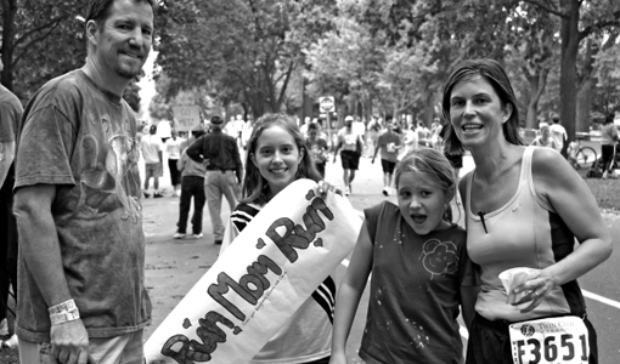My first encounter with the Twin Cities Marathon was the $35 parking ticket I received while living on Otis Avenue, just west of the St. Thomas campus in St. Paul, in 1987. Little did I realize that nearly 20 years later, the country’s most beautiful urban marathon would cost me much more, yet over-deliver on its promise as a life-changing, exhilarating experience.
For I am now a marathoner.
I’ve been hooked on running ever since I completed my first mile in freshman gym class. Prior to college, running was a chore and done only as a requirement. But at St. Thomas a small group of girlfriends and I waged war against the Freshman 15 by pounding the pavement along the Mississippi River. We never ran more than three miles, which always felt like an amazing accomplishment.
Three miles was my distance for many years. I ran two to three times a week while balancing motherhood and a career in public relations. But somewhere along the way, I began to harbor a desire to run a marathon before turning 40. I’m not normally a goal-setter, but I am self-motivated as well as self-conscious … so once I stated this goal to family and friends, I had to run a marathon by 2006.
With my clock ticking, I found myself fascinated with marathoners. I cornered runners at parties, coffee shops and school events, asking everything from what shoes they wore to what protein bar they preferred. All the while, I stuck to my consistent three-mile routine. It wasn’t until my younger sister was injured and couldn’t run in the Twin Cities Marathon’s 10-mile race that I started to build up my own mileage. I took her number and completed the race. That was four years ago. At the time, it was the farthest I had ever run. I distinctly recall running up from the river and seeing St. Thomas. It was beautiful, and just seeing the campus gave me a much-needed adrenaline push.
Completing 10 miles was incredibly motivating. It gave me self-confidence, strength and a sense of inner peace. Running always has been my preferred form of therapy, and you can work through a lot of issues over those 90 minutes.
But 10 miles is a whole lot less than 26.2. And while my mind solved problems on short runs, it created many more when I actually committed to the marathon. I don’t do failure. But here I was, setting myself up for one of the hardest physical and mental challenges of my life.
To hell and back
Registering to run a marathon is easy. Anyone can do it (at least for Twin Cities) and it only costs $75. But once you commit, you embark on an expensive journey to hell and back.
Running isn’t supposed to be expensive, but most marathoners are obsessive freaks. We require the latest and greatest gadgets. If you’re going to run for more than four hours, you need to be as comfortable, entertained and well fed as possible. I spent $1,000 leading up to my first marathon. My necessities, in order of importance, were excellent shoes (Asics Gel-Kayano are worth every penny); an iPod (Nano with an arm band is the lightest, most unobtrusive music player); a fuel belt (I fill all four bottles with Shaklee’s Performance sports energy drink); a sports watch (my Nike watch measures distance, has a heart monitor and syncs with my computer’s training software); and finally, great socks (no cotton).
I made my smartest purchase two weeks before the marathon. The Non-Runner’s Marathon Trainer (authors Whitsett, Dolgener and Kole) is a godsend that was recommended by Lisa Anderson, a college friend and marathoner. Along with a training schedule, the book provides mile-by-mile mental strategies to remain positive and focused throughout a marathon. Had I known of the book months before, I’m convinced my training experience would have been different.
Marathoners talk of hitting “the wall,” usually around mile 18 when the body and mind near exhaustion. I hit “the wall” during an 18-mile training run five weeks before the race. I had been struggling to push myself past 12 miles. I preferred to run by myself yet worried that I’d need the support of others to make it through training. So I joined a running club for my first 18-miler. Not smart. These people had been running together for weeks building mileage. They were fast. I was intimidated. I started uncontrollably shaking the moment I met them. Negative thoughts of not being good enough started to swirl. Consequently, the group broke away from me around mile 8.
Meeting the running angel
While I managed to keep it together for a few more miles, I stopped around mile 14. Breaking into tears, I admitted that I couldn’t do this. While most people complain of the time it takes to train, I couldn’t handle the actual distance. As I was sobbing and walking the final few miles to my car, I experienced my first brush with a running angel. Running angels are the positive people who acknowledge the difficulty yet stalwartly believe in you, even though you’ve never met them.
Up until this point, I had believed marathon training ran a parallel course to pregnancy. Just like having a baby, there’s never really a good time to run a marathon. You’re terrified for months, wondering if you’re strong enough to get through the final push. Instead of stretch marks, toes turn black from banging against shoes. Absolutely everyone you meet has a comment, question or piece of advice. There are the “shocked and awed” who can’t imagine running three miles, let alone 26.2, and their eyes go wide as they exclaim that you are insane.
There are the quiet supporters, like my husband, who believe in you wholeheartedly yet would never set such a goal for themselves and can’t quite figure out why you did. Finally, there are those who understand and carry the same dream or aura of accomplishment. These people often are running angels.
My first angel told me to brush off my failed attempt at 18 miles; to acknowledge a bad day today but that tomorrow will be better. Proper rest and eating are crucial to training and the night before I was up late at a party, drinking red wine. No wonder my mind and body quit. Next week, eat right, sleep right and complete 18. OK. As I walked away, I suddenly felt re-energized. I got mad at myself for giving up. I ran to Lunds, slammed down a Diet Coke and a power bar and then completed my first 18-miler.
As I finished the run, I thought long and hard about why I was doing this. It may sound odd, but my sole reason for running a marathon was that I could. Running a marathon isn’t possible for many people, but it was for me. I was in good shape and good health and, most of the time, I had the right attitude.
After that, I ran smarter. And I asked for help. My husband, Greg, offered to meet me at regular intervals to provide encouragement and replacement fluids. He memorized and marked the race route. During my last long training run, I left my house in south Minneapolis and ran the course all the way to the State Capitol. Greg met me at pre-determined locations along the way and ran up Summit Avenue with me. My daughter, Emma, biked the entire distance alongside me. It was a 92-degree Sunday: not ideal running conditions, and once again, I started to doubt my sanity. By the time I reached St. Thomas, I was drained. Fortunately, there was a bike race that day and the Summit parking lot was crowded with support tents. I stopped and stole water and a banana for sustenance. A walk around the quad provided further relief and mental fuel. As we started the long, slow climb of Summit, I wondered what it would be like to pass by St. Thomas on marathon day.
St. Thomas at mile 20
St. Thomas sits at mile 20. The wall of the football stadium is your first view coming up from the river. During the actual race, it was a tremendous moment for me. Not only was I finished with the river (the four-mile stretch from Minnehaha Falls to Summit proved to be my toughest mentally and physically), St. Thomas heralded the final stretch. The crowds were amazing, and I found it was the crowds that carried me. I was jazzed. I smiled, laughed and talked with runners and spectators alike. I honored every mile I passed by lightly tapping the mile marker and saying thanks. My husband and daughters met me every five miles. The experience was simply phenomenal. I got lost in it and ran in awe of my new found positive mindset.
Stopping to talk with my family at St. Thomas was unforgettable. St. Thomas is where I first started to run 20 years ago, where I first realized my physical abilities matched my mental and that I was a strong, more-than-capable woman.
I finished my first marathon just eight days before turning 39. My time was slow. Incredibly, embarrassingly slow; however, only 7,500 or so people actually finished the 2005 Twin Cities Marathon. I was one of them and I enjoyed every single step of the journey.
I’ll run my second marathon just days before turning 40.
Jackie Peacha ’89, a freelance writer and public relations specialist, lives in Minneapolis with her husband, Greg Hennes ’85, and their four children.







